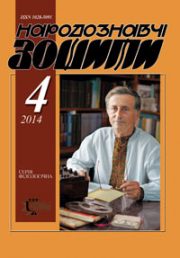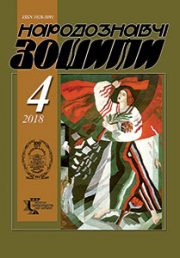The Ethnology Notebooks. 2019, № 6 (150), 1620—1625
UDK745/749(477.8325)П.Запоріжський
DOI https://doi.org/10.15407/nz2019.06.1620
NOHA Oleksandr
ORCID ID: https://orcid.org/0000-0003-4089-9404
Ph.D in Art Studies,
Senior Researcher at the Art Studies Department,
The Institute of Ethnology of the National Academy of Sciences of Ukraine.
15 Svobody Avenue, 79000, Lviv, Ukraine.
e-mail: ina@mail.lviv.ua
SAVYTSKYJ Igor
Director of the sports organization «Lviv Polytechnic»,
National University «Lviv Polytechnic»
12 Stepan Bandera Street, 79000, Lviv, Ukraine
e-mail: savytsky62@gmail.com
Abstract. Introduction.The article elucidates the life and creative activity of a little-known Ukrainian icon-painter who worked in Western Ukraine and Lemky region during the 1930—1940s. Pavlo Zaporizhskyj came from a Cossack family, born in the town Kropyvnytskyi (previous Jelisavetgrad). The boy showed the ability to draw in his childhood. With the support and encouragement of his parents, he evelopped his talent, got a good education. Pavlo Zaporizhskyj got his basic art knowledge at the Evening Drawing Courses in Jelisavetgrad, improving his skills at the Art School of Odessa, at that time a significant art center. After World War I, the young artist found himself in the Western Ukraine.
Problem statement. Pavlo Zaporizhskyj boldly declared his national identity, and therefore was included in the list of artists forbidden by the Soviet totalitarian regime. He was not mentioned, his works — above all icons and church wall paintings — were destroyed, archiv materials were hidden. Meanwhile, even the single facts that have been preserved about the Pavlo Zaporizhskyj’s life and work testify to his important role in the Ukrainian church art formation during the interwar period.
The purpose of the article is to study the creativity of the artist who was forced to live and work in the difficult times of the formation of modern Ukrainian culture.
Results. Through his activities Pavlo Zaporizhskyj showed the unity of the Ukrainian people from East to West of our country. He was one of ten participants in the Art Workshop «Renaissance», founded in Przemysl in the early 1920s. The workshop became famous for a large number of quality paintings in the Ukrainian churches, iconostases and icons in all Western Ukrainian region. Pavlo Zaporizhskyj’s works were distinguished by their careful manner of execution, bright colors, thoughtful composition.
Conclusions. The Pavlo Zaporizhskyj’s heritage needs deep study, and his name is worthy of being returned to the treasury of Ukrainian culture.
Keywords: icon painter, Ukrainian church, wall painting, the twentieth century art.
Received 7.11.2019
REFERENCES
Rakovskyj, I. (Ed.). (1930). Ukrainian General Encyclopedia: in 3 v. Lviv; Stanislav; Kolomyia [in Ukrainian].
Krypjakevych, I. (1990). History of Ukraine. Lviv: Svit [in Ukrainian].
The fate of our painters. (1896). Dilo, 54. Lviv [in Ukrainian].
Suprunenko, M. (Ed.). (1988). The great October and civil war in Ukraine. Kyiv [in Ukrainian].
Tananaeva, L.I., & Sakovich, A.G. (1983). Primitive and its place in the artistic culture of Modern and Contemporary. Moscow: Nauka [in Russian]
Aleksandrenko and contemporary Ukrainian art. (1911). Iskustvo, 10. Moscow [in Russian].
Doroshenko, S., & Samiliak, T. (Eds.). (2004). City and people: Elisavetgrad — Kirovograd, 1754—2004. Kirovograd: Ineks-LTO [in Ukrainian].
Koval, M.V. (1965). Kirovograd region during the Great Patriotic War in 1941—1945. Dnipropetrovsk: Promin [in Ukrainian].
Herasymenko, K.V. (1922). Makhno: Memoirs. Istorik i sovremjennik, 3, 151—201 [in Ukrainian].
Antonovych, M. (1942). History of Ukraine. Praha: Yurij Tyshchenko Publishing House [in Ukrainian].
Korol, N. (1963). Ukrainian Cossacks. New‑York: NTSh [in Ukrainian].
Lazarevskyj, A. (1888). Opysanye staroj Malorossyy: Materyaly dlia ystoryy zaselenyia, zemledelyia y upravlenyia v 3 t. Kyiv [in Ukrainian].
Javornytskyj, D. (1883). The life of Zaporizhzhya Cossacks according to the story of a contemporary eyewitness. Kievskaja starina, 13 [in Russian].
Lazarevskyj, A. (1902). Ukrainian Cossacks in the 1720s. Reading of the Historical Society of Nestor the Chronicler, 15, 75—78.[in Russian].
Huchnystyj, D. (1954). Zaporizhska Sich and its progressive role in the history of the Ukrainian people. Kyiv [in Ukrainian].
Herij, O., Turkevych-Klimashevskyj, A., Kodlubaj, I., & Noha, O. (2012). Ukrainian Church Art (1880—1920). Lviv: Ukrainski tekhnologii [in Ukrainian].
Lobanovskyj, B., & Hovdia, P. (1983). Ukrainian art of the first half of the nineteenth — early twentieth centuries. Kyiv: Mystetstvo [in Ukrainian].
Brodskyj, N.I. (1940). My career. Leningrad; Moscow [in Russian].
Lobanovskyj, B.B. (1978). A book for reading in Ukrainian art. Kyiv: Radianska shkola [in Ukrainian].
Dzyuba, I.M. (Ed.). (2010). Encyclopedia of modern Ukraine (Vol. 10). Kyiv [in Ukrainian].
Bandrivskyj, M. (2009). From the history of the Apostles Peter and Paul church in Lviv. Lviv [in Ukrainian].
Savchuk, M. (2001). Enigmatic Pavlo Zaporizhskyj. Nashe slovo, 54. Peremyshl [in Ukrainian].
Pavlo Zaporizhskyj. (1922). Ukrainskyj holos, 16 (144) [in Ukrainian].
Kolianchuk, O. (2006). Pavlo Zaporizhskyj or Zaporozhskyj, Zaporozhchenko. Art-painter from the Great Ukraine. Tserkovnyj kalendar, 06. Sianok [in Ukrainian].
Yarema, O. (2010). Patriarch Dimitri and Pavlo Khoma. Uspenska vezha, 7 (217). Lviv [in Ukrainian].
Koval, Ya. (1993). Ivan Kosynin. Ukrainskyj kalendar. Warsaw [in Ukrainian].
Memoirs I.F.K. (1946). TsDIA. F. 309. Op. 1. Zv. 100. Od. zb. 1480. Lviv [in Ukrainian].
Memoirs I.F.K. (1946). TsDIA. F. 309. Op. 1. Zv. 100. Od. zb. 1481. Lviv [in Ukrainian].






